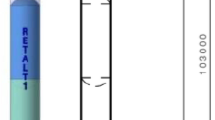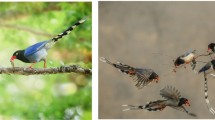Abstract
This work performs a computational investigation of the energy variations given by a powered Swing-By maneuver realized in an elliptical system. It extends previous works by giving the freedom to choose the location and the direction of the thrust vector, aspects that were not considered before in the literature. Those variations are obtained numerically as a function of the parameters related to the thrust (magnitude, direction and location of the application) and the orbital parameters of the primaries (eccentricity and true anomaly). The maneuver is realized around the smaller primary, and the energy variations are measured with respect to the main body of the system. The initial orbit of the space vehicle is defined by its periapsis distance, angle and approach velocity with respect to the smaller primary. The study is applied to a system composed of two primaries that are in elliptic orbits around the center of mass of the system. The eccentricity is varied as a free parameter, to measure its effects. The results show that the best maneuvers apply the thrust at a point inside the sphere of influence of the secondary body, but not in the periapsis of the orbit. The best direction of the thrust is not aligned with the motion of the space vehicle. The techniques studied here are applied in situations where it is desired to increase the energy of the space vehicle. Empirical equations are obtained for the energy variations, based on the simulations made in the present paper. The numerical approach makes the results more accurate and not limited to particular regions of the eccentricity.

















Similar content being viewed by others
References
Minovitch MA (1961) A method for determining interplanetary free-fall reconnaissance trajectories. JPL, Pasadena. (JPL Tec. Memo 312-130)
Dowling RL, Kosmann WJ, Minovitch MA, Ridenoure RW (1990) The origin of gravity-propelled interplanetary space travel. In: Congress of the international astronautical federation, 41, 1990, Dresden, GDR. Proceedings… IAA, Dresden
Dowling RL, Kosmann WJ, Minovitch MA, Ridenoure RW (1991) Gravity propulsion research at UCLA and JPL 1962–1964. In: 41st Congress of the international astronautical federation, Dresden, GDR
Flandro GA (1966) Fast reconnaissance missions to the outer solar system utilizing energy derived from the gravitational field of Jupiter. Astronaut Acta 12(4):329–337
Damario LA, Byrnes DV, Stanford RH (1982) Interplanetary trajectory optimization with application to Galileo. J Guid Control Dyn 5:465–471. https://doi.org/10.2514/3.56194
Byrnes DV, D’amario LA (1982) A combined Halley flyby Galileo mission. In: AIAA/AAS astrodynamics conference, San Diego, CA, AIAA paper 82-1462
McNutt RL, Solomon SC, Grard R, Novara M, Mukai T (2004) An international program for Mercury exploration: synergy of MESSENGER and BepiColombo. Adv Space Res 33(12):2126–2132. https://doi.org/10.1016/S0273-1177(03)00439-3
McNutt RL, Solomon SC, Gold RE, Leary JC (2006) The MESSENGER mission to Mercury: development history and early mission status. Adv Space Res 38(4):564–571. https://doi.org/10.1016/j.asr.2005.05.044
Grard R (2006) Mercury: the messenger and bepicolombo missions a concerted approach to the exploration of the planet. Adv Space Res 38(4):563
Greenberg R, Carusi A, Valsecchi GB (1988) Outcomes of planetary close encounters: a systematic comparison of methodologies. Icarus. https://doi.org/10.1016/0019-1035(88)90125-X
Carusi A, Valsecchi GB, Greenberg R (1990) Planetary close encounters: geometry of approach and post-encounter orbital parameter. Celest Mech Dyn Astron 49(2):111–131
Campgnola S, Skerrit P, Russel RP (2012) Flybys in the planar, circular, restricted, three-body problem. Celest Mech Dyn Astron 113:343–368. https://doi.org/10.1007/s10569-012-9427-x
Gomes VM, Oliveira GMC, Prado AFBA, Sanchez DM (2016) Close approach of a cloud of particles around an oblate planet. Comput Appl Math 35:673. https://doi.org/10.1007/s40314-015-0264-x
Santana SHS, de Melo CF, Macau EEN (2016) Exploring the Moon gravity to escape from the Earth–Moon system. Comput Appl Math 35:701–710
Negri RB, Prado AFBA, Sukhanov AA (2017) Studying the errors in the estimation of the variation of energy by the “patched-conics” model in the three-dimensional swing-by. Celest Mech Dyn Astron 129:269–284. https://doi.org/10.1007/s10569-017-9779-3
Qi Y, de Ruiter A (2018) Energy analysis in the elliptic restricted three-body problem. Mon Not R Astron Soc 478:1392–1402. https://doi.org/10.1093/mnras/sty1155
Gagg Filho LA, Fernandes SS (2018) Interplanetary patched-conic approximation with an intermediary swing-by maneuver with the moon. Comput Appl Math 37:24–54
Broucke RA (1988) The celestial mechanics of gravity assist. In: AIAA/AAS astrodynamics conference, Minneapolis, MN, AIAA paper 88-4220 1988
Prado AFBA (1996) Powered Swing-By. J Guid Control Dyn 19:1142–1147
Casalino L, Colasurdo G, Pastrone D (1999) Optimal low-thrust escape trajectories using gravity assist. J Guid Control Dyn 22:637–642. https://doi.org/10.2514/2.4451
Casalino L, Colasurdo G, Pastrone D (1999) Simple strategy for powered Swing-By. J Guid Control Dyn 22:156–159
Ferreira AFS, Prado AFBA, Winter OC (2015) A numerical study of powered Swing-Bys around the Moon. Adv Space Res 56:252–272. https://doi.org/10.1016/j.asr.2015.04.016
Ferreira AFS, Prado AFBA, Winter OC (2017) A numerical mapping of energy gains in a powered Swing-By maneuver. Nonlinear Dyn 89:791–818. https://doi.org/10.1007/s11071-017-3485-2
Hollister WM, Prussing JE (1966) Optimum transfer to Mars via Venus. Acta Astronaut 12(2):169–179
Dunne J A, Burgess E (1978) The voyage of Mariner 10. National Aeronautics and Space Administration SP 424
Striepe SA, Braun RD (1991) Effects of a Venus Swing-By periapsis burn during an Earth–Mars trajectory. J Astronaut Sci 39(3):299–312
Jehn R, Companys V, Corral C, Yárnoz DG, Sánchez N (2008) Navigating BepiColombo during the weak-stability capture at Mercury. Adv Space Res 42(8):1364–1369
Ferreira AFS, Prado AFBA, Winter OC, Santos DPS (2017) Studying the energy variation in the powered Swing-By in the Sun-Mercury system. J Phys Conf Ser 911:012007. https://doi.org/10.1088/1742-6596/911/1/012007
Ferreira AFS, Prado AFBA, Winter OC, Santos DPS (2019) Effects of the mass parameter in the optimum direction of impulse and energy variation in a powered Swing-By. J Phys Conf Ser 1365:012008. https://doi.org/10.1088/1742-6596/1365/1/012008
Ferreira AFS, Prado AFBA, Winter OC, Santos DPS (2017) Effects of the eccentricity of the primaries in powered Swing-By maneuvers. Adv Space Res 59:2071–2087. https://doi.org/10.1016/j.asr.2017.01.033
Silva AF, Prado AFBA, Winter OC (2013) Powered swing-by Maneuvers around the Moon. J Phys Conf Ser 465:012001. https://doi.org/10.1088/1742-6596/465/1/012001
Szebehely V, Giacaglia GEO (1964) On the elliptic restricted problem of three bodies. Astron J 69:230. https://doi.org/10.1086/109261
Szebehely V (1967) Theory of Orbits. Academic Press, New York
Murray CD, Dermott SF (1999) Solar system dynamics, 1st edn. Cambridge University Press
Araujo RAN, Winter OC, Prado AFBA, Vieira MR (2008) Sphere of influence and Gravitational Capture radius: a dynamical approach. Mon Not R Astron Soc 391(2):675–684. https://doi.org/10.1111/j.1365-2966.2008.13833.x
Ferreira AFS, Prado AFBA, Winter OC, Santos DPS (2018) Analytical study of the powered Swing-By maneuver for elliptical systems and analysis of its efficiency. Astrophys Space Sci 363:145. https://doi.org/10.1007/s10509-018-3362-6
Ferreira AFS, Prado AFBA, Winter OC, Santos DPS (2018) Analytical study of the Swing-By maneuver in an elliptical system. Astrophys Space Sci 363:24. https://doi.org/10.1007/s10509-017-3242-5
Ferreira AFS, Prado AFBA, Winter OC (2018) Planar powered Swing-By maneuvers to brake a spacecraft. Comput Appl Math 37:202–219. https://doi.org/10.1007/s40314-017-0483-4
Acknowledgements
The authors wish to express their appreciation for the support provided by Grants #305210/2018-1, 300923/2017-1, 406841/2016-0 and 301338/2016-7 from the National Council for Scientific and Technological Development (CNPq); Grants #2019/15180-0, 2016/24561-0 and 2016/23542-1 from São Paulo Research Foundation (FAPESP) and the financial support from the Coordination for the Improvement of Higher Education Personnel (CAPES).
Author information
Authors and Affiliations
Corresponding author
Ethics declarations
Conflict of interest
The authors declare that they have no conflict of interest.
Additional information
Technical Editor: Flávio Silvestre.
Publisher's Note
Springer Nature remains neutral with regard to jurisdictional claims in published maps and institutional affiliations.
Appendices
Appendix 1: Coefficients of the empirical equations of \(\Delta E_{\max }\)
See Table 4.
Appendix 2: Maps of the differences between \(\Delta E\) and \(\Delta E_{{\theta = 0^{ \circ } }}\) (in canonical units–c.u.)
Rights and permissions
About this article
Cite this article
Ferreira, A.F.S., de Moraes, R.V., Prado, A.F.B.A. et al. A computational approach to the powered Swing-By in the elliptic restricted problem. J Braz. Soc. Mech. Sci. Eng. 43, 186 (2021). https://doi.org/10.1007/s40430-021-02914-9
Received:
Accepted:
Published:
DOI: https://doi.org/10.1007/s40430-021-02914-9







